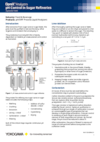Upcoming Events
-
Webinar Aug 22, 2024 11:00 AM Free Online WebinarThe Mystery of the Very, Nearly Impossible pH Measurement
In this webinar, we will explore the following:
- Unraveling the Theory Behind pH
- Identifying Issues Behind pH Measurements
- Dissecting Standard vs. Solution Temperature Compensation
- Examine Installation Requirements for Success
- Clarify Good Calibration and Maintenance Procedures
-
Conference Oct 7 - 9, 2024 New Orleans, LAWEFTEC 2024
Yokogawa is excited to attend WEFTEC’s 97th Annual Exhibition & Conference, the premier event where networks expand, ideas become solutions, and water quality innovation and expertise are on display.
What Is a Liquid Analyzer?Liquid pH ORP analyzers and conductivity analysers are used for monitoring process chemistry including water quality, providing process optimization and control. Common measurements include pH, ORP, conductivity, resistivity, percent concentration, and dissolved oxygen. What Are the Industrial Applications of Liquid Analyzers?
What Is Conductivity in Water Treatment?In water treatment, water must pass a conductivity test to see if it passes an electrical current. Conductivity in water is related to inorganic solids, including ions carrying a negative charge (chloride, nitrate, sulfate, phosphate anions) and ions carrying a positive charge (sodium, magnesium, calcium, iron, aluminum cations). The conductivity level of water is also dependent on temperature. What Are the Benefits of Liquid Analyzers?Liquid analysis is essential for protecting critical and essential assets including boilers and cooling towers, by preventing corrosion, minimizing maintenance, and maximizing uptime. Yokogawa is a recognized world leader for reliable liquid analytical equipment, providing accurate and repeatable solutions for maintaining and controlling even the most demanding process optimization and control applications with unparalleled ease of operation. |
 Use our Liquid Analyzer Sensor Wiring Guide to easily find the correct wiring for your liquid analyzer sensor. |
-
SENCOM™ SMART Digital Sensors
Reduce configuration time and simplify maintenance
-
pH and ORP Analyzers
Optimize and eliminate surprise field maintenance, calibration, and system configuration
-
pH and ORP Sensors
Ensure fluid process operations
-
Conductivity Analyzers
Maintain and control even the most demanding process applications
-
Conductivity Sensors
Measure aqueous solutions quickly and reliably
-
Dissolved Oxygen Analyzers
- Dissolved Oxygen (DO) meters, analyzers and transmitters
- Continuous process measurement and monitoring
- Milligrams per liter (mg/l),parts per million (ppm), parts per billion (ppb), or % saturation.
-
Dissolved Oxygen Sensors
- Dissolved Oxygen (DO) sensors/electrodes
- Polarographic, galvanic, optical measurement
- Floating ball, retractable, flow thru, immersion, direct insertion installation
-
Turbidity Analyzers
- TB820D next-generation digital Turbidity meter
- Turbidity analyzer connects to FLXA402T.
- LED light source, flat window structure cell, new diagnostic functions, ultrasonic cleaning
-
Chlorine Analyzers
- Non-reagent type chlorine analyzer for measuring free chlorine
- Reagent type chlorine sensor for measuring free chlorine or residual chlorine (total chlorine)
-
Product Finder
This web tool makes it easier to find products according to the application, measurement conditions and required specifications.
Resources
Water Supply Treatment
FAST/TOOLS, STARDOM, Flowmeters, Liquid Analyzers
- Bali's water treatment plant decided to employ the latest reliable control system in order to increase availability and quality of operation.
- Centralized control system using FAST/TOOLS provides the sophisticated and flexible operation.
SMART digital sensors and advanced data management software enhance reliability and process safety.
Conductivity measurement can be used as a reliable indicator of the real-time brine concentration. Using an online process analyzer removes the need for timely grab sample analysis.
Dairy wastewater is a mixture of organic compounds, suspended solids, fats, and bacteria that can produce a film or coating on equipment in the process.
Problems at the wet end of a paper machine can rarely be corrected downstream. That is why monitoring and controlling pH in pulp stock is critical to the paper-making process. Essentially, at every stage in the manufacture of paper, correct pH values play a vital role. Variations in the pH value at the headbox have a negative effect on the quality of the paper produced. Proper monitoring ensures minimizing plugging and fouling problems that occur with pH measurements in paper mills.
After extraction from sugar cane or sugar beets, the juice must be purified to remove the many other organics and minerals that accompany it. The processing to accomplish this is heavily dependent on reliable pH measurement and control as illustrated.
Yokogawa’s Process Liquid Analyzers series help pigment producers achieve a more reliable and accurate analysis of pH during industrial bioprocesses, improving product quality with less total operation costs.
Read this eBook to learn how to best leverage the latest measurement instrumentation to avoid incidents and improve productivity. You will also find valuable information about overcoming common CIP challenges and stories of success.
Are you trying to decide how to tackle that next challenging application? Join our Back to Basics webinar series as we review the fundamentals behind different measurement technologies. We will discuss recommended practices, application selection, and sizing, and how to avoid common pitfalls. Gain insight directly from our experts!
Get the most from what exists currently and take advantage of new methods. Appeared in the March 2021 issue of an ISA.org publication.
Downloads
Brochures
- Liquid Analyzer Sensors and Fittings (5.9 MB)
- Liquid Analyzers in the Water Industry
- Importance of Analyzer Maintenance (194 KB)
- Process Analyzers Analytical Instruments and Systems Overview
- Preserving Our Water Resources One Drop at a Time (6.5 MB)
- Product Solution Catalog Applications (2.8 MB)
- FLXA402 4-Wire Liquid Analyzer, SA11 SENCOM Smart Adapter (2.9 MB)
- Water Industry Solutions (739 KB)
- Electrolysis Solutions: Instrumentation Solutions for Electrolysis Plant Applications (841 KB)
- SENSTATION (492 KB)
Instruction Manuals
- Model FF20 Flow fittings Model FS20 Subassembly flow fittings Model FD20 immersion fitting (3.4 MB)
- Model FU24F pH/ORP SENCOMR sensor (1.3 MB)
- Model PH202SJ [Style: S2] 2-wire pH/ORP Transmitter (293 KB)
- Electrodes - Instructions for placing colour code marks (87 KB)
- ISC202SJ [Style: S1] 2-wire Inductive Conductivity Transmitter with Supplement (371 KB)
- SC202SJ [Style: S2] 2-wire Transmitter for Conductivity or Resistivity with Supplement (1.3 MB)
- SS400G MLSS Converter (3.7 MB)
- PH8USF ULTRASONIC OSCILLATOR (Explosionproof Type) and PH8AL ALARM BOX (889 KB)
General Specifications
Technical Information
- pH/ORP Analyzer Selection Guide (726 KB)
- FLXA202/FLXA21 2-Wire Analyzer HART Communication (1.9 MB)
- Choosing the Right Electrodes (720 KB)
- FLEXA/EXA PH Series Process pH Meters Basic and Products (1.2 MB)
- Contacting Conductivity sensor selection guide (1.6 MB)
- Cation Differential Quick Start Guide (1.4 MB)
- Conductivity Analyzer Guide (992 KB)
- Process Liquid Analyzer Sensor Wiring Guide
- Boiler Life Cycle Considerations
- Back to the pHuture - pH and ORP Learning Handbook (8.3 MB)
Videos
SENCOM- The Next Generation in SMART Liquid Analyzers
Yokogawa’s SENCOM SMART Sensor Platform is an innovative analyzer platform that optimizes maintenance, reduces configuration time, and simplifies in-field maintenance and calibration. Yokogawa is a recognized world leader for reliable liquid analytical equipment, providing accurate and repeatable solutions for maintaining and controlling even the most demanding process applications.
Nick Crowe discusses whether to calibrate or validate your analyzers. He demystifies the differences between both options and uncovers the truth about performing either.
We invited Nick Crowe, our Product Manager for Analytical Products to debunk myths around Liquid Analysers. In part 1 of this series, Sean asked him whether the maintenance-free analyzer is a myth?
News
-
Press Release Mar 27, 2012 Yokogawa Releases New 2-Wire Transmitter FLXA21®
Looking for more information on our people, technology and solutions?
Contact Us












